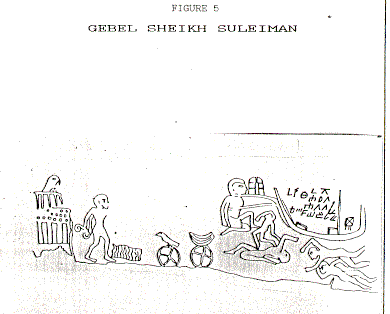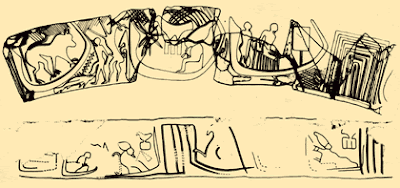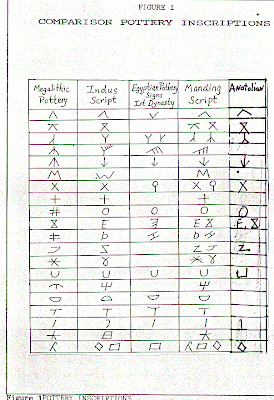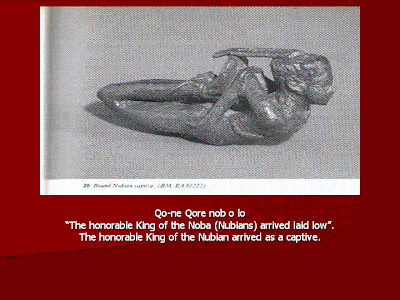I have deciphered Meroitic based on the most logical path to the decipherment of any dead language. Maurice Pope , made it clear that before a dead language can be deciphered you must have the right theoretical structure to base your inquiry upon it (p. 191).
There were three preliminary conditions that must be met before any decipherment: (1) confidence that a script can be deciphered; (2) location of proper names must be determined; (3) the grammatical rules of the target language must be known.
Conditions #1 and #2 were met by Griffith when he deciphered the Meroitic script in 1910, and his discovery of the proper names of the Meroitic gods and individuals in the Meroitic text.
Griffith also discovered the directions in which the Meroitic writing was written. The recognition for the solubility of Meroitic was reinforced by the publication of it because it provided up-to-date material on Meroitic and the idea of using the comparative method to decipher Meroitic.
Condition #3 was met in 1978 when Hintze published his work on Meroitic grammar. This allowed me to test other languages similar to Meroitic to find the cognate language.
I chose Kushana for two reasons. Firstly, Philostratus in , claimed that the Gymnosophists of Kush, who settled along the Nile, descended from the Brahmins of India, having been forced to migrate after the murder of their King. This passage pointed to the Kushana, who left China in 176 B.C., after the murder of their king. The Kushana were of high caste.
The Meroites and Kushana often referred to themselves as Kuš . Because both of these groups called themselves Kushana, it suggested that they may be related, given the Classical tradition for a migration of "Indians" to Kush. Moreover, C.B. Rawlinson, in "Notes on the early History of Babylonia," pp. 221-222, discussed the Kushites of Asia and Africa.
Using the evidence of classical traditions pointing to the Kushana as possible settlers of Meroë gave me the confidence to compare Kushana to Meroitic. This comparison proved fruitful.
The key to understanding the use of Kushana/Tokharian to write Meroitic depended on the multi-lingual/ethnic character of the Kushana language. Although this language is considered Indo-European, I believe that it was used as a trade language in Central Asia to give the people of the region a common medium of exchange.
The Meroitic empire was made up of many groups: the Kusa/Kushites, Blemmyans, Medes, and Reherahas according to Hakem and Millet. I believe that the Meroites recognized the possibility of using Tokharian, which I believe was a trade language , in Meroitic Kush to unite the diverse people living in the region because it was not of Egyptian origin.
There is disturbing linguistic evidence that hinders the proper placement of Kushana/Tokharian in the I-E family. This results from the fact that it is more closely related to the western branch of I-E, than Indo-Iranian its closest neighbor. The Tokharian isoglosses in I-E are ranked as follows: (1) Germanic, (2) Greek, (3) Indic, (4) Baltic, and (5) Iranian.
The Tokharian lexicon has also been influenced by Tibetan, Chinese, and Uighur. This is suggestive that Tokharian was a trade language and that Greek and Slavic words came into the "lingua franca" after the Greek conquest of Bactria. The borrowing pattern in Tokharian is consistent with the spread of the Greek language by a small politically dominant minority of Greek settlers into a far larger and previously long-established non–I-E speaking majority. My decipherment of Meroitic is based on the Kushana theory.
The Kushana theory is that a group of “East Indian” scholars introduced the Meroitic writing system to the Meroites.
The Kushana hypothesis was based on the following evidence, 1) no African language has been found to be a cognate language of Meroitic 2) the Classical literature says that the Kushites lived in Asia and Africa; 3) the Gymnosophists, or "naked sages" of Meroe came from India.
Before I began work on Meroitic, other researchers had already falsified the African theory for Meroitic's cognate language. Meroitic is not related to languages spoken in this area. Griffith and Haycock tried to read Meroitic using Nubian and failed. K.H. Priese tried to read the Meroitic text using Eastern Sudani; he also failed.
The fact that not even Nubian, a language spoken by a people who were engaged in constantly conflict with the Meroites , failed to be the cognate language of Meroitic made it clear that we must look elsewhere for the cognate language spoken by the Meroites.
The idea that the Meroites spoke Nubian has been revised by Rilly. Recently Rilly has suggested that we may be able to read Meroitic using Proto-Eastern Sudanic. We must reject this alledged break through in Meroitic linguistics on two points, he believes Nubia can be used to interpret Meroitic when the Nubians were never part of the meroitic Confederation; and 2) you can not read a dead language based on proto-terms because a proto-language is purely theorectical and can not be proven as ever existing in the real world.
Flavius Philostratus, the writer of the
Vita Apollonii, Vol.1 , claimed that the
Gymnosophists of Meroe originally came from India (see F.C. Conybeare, Philostratus:The Life of Apollonius of Tyana(p.45),1950). Given the fact that the Kushana had formerly ruled India around the time that the Meroitic writing was introduced to the Kushite civilization, led to the hypothesis that the ancestors of the Gymnosophist may have been Kushana philosophers.
The historical evidence of the Kushana having ruled India made the Classical references to Indians in Meroe, an important source for the construction of alternative theories about the possible location ofthe cognate language of Meroitic.
There is external evidence, which supports my theory. A theory explains observed phenomena and has predictive power. I have theorized that due to the claims of the Classical writers that some of the Meroites came from India (F.C Conybeare (Trans.), Philostratus:
The life of Apollonius of Tyana Vol.2, (1950) pg.271). According to the
Life of Apollonius, the Indian Meroites were formerly led by a KingGanges, who had "repulsed the Scythians who invaded this land [India from] across the Caucasus" (Conybeare, Vol.1, Pg.273). Pilostratus also made it clear that the Indians of Meroe came to this countryafter their king was killed.
The presence of this tradition of an Indian King of the Indian-Meroites conquering the Scythians predicts that the Indian literature should record this historical episode. This prediction is supported by aJaina text called the
Kalakeharya-Kathanaka, which reports that when the Scythians invaded Malwa, the King of Malwa, called Vikramaditya defeated the Scythians (H. Kulke & D. Rothermund,
History of India(London, Routledge: 1990, pg.73). This king Vikramaditya may be the Ganges mentioned in the Life of Apollonius.Confirmation of the Ganges story,supports the Classical literary evidence that their were Indianized -Meroites that could have introduced the Tokharian trade language to the Meroites.
In addition to the classical mention of the Indians settling Meroë, we also have a horde of
Kushana coins that were found on the floor of a cave at the present monastery-shine at
Debra Demo in modern Ethiopia in 1940. Moreover, there were other Indians in North Africa in addition to Kush/Meroe. For example, at Quseir al-Qadim there was a large Indian speaking community (see: R. Salomon,
"Epigraphic remains of Indiantraders in Egypt",
Journal of the American oriental Society, (1991) pp.731-736; and R. Salomon,
Addenda,
Journal of the American Oriental Society, (1993) pg.593). These Indians were in Egypt writing messages in their own language, around the time we see a switch from Egyptian hieroglyphics to the Meroitic writing system. All of this supported the traditions of the Meroites that speak of a knowledge of the Kushana/Indians among the Meroites.
The evidence that the Classical references to an Indian-Meroite King who conquered the Scythians is supported by the Indian literature, provides external corroboration of the tradition that some of the Meroites were of Indian origin. The presence of Indian traders and settlers in Meroe (and Egypt), makes it almost impossible to deny the possibility that Indians, familiar with the Tokharian trade languagedid not introduce this writing to the Meroites who needed a neutral language to unify the diverse ethnic groups who made up the Meroite state. In relation to the history of linguistic change and bilingualism, itis a mistake to believe that linguistic transfer had to take place for the Meroites to have used Tokharian, when it did not take place when they wrote in Egyptian hieroglyphics.
In summary the classical literature makes it clear that there was a connection between the Gymnosophists (of Meroe) and the Indians. The fact that historical events mentioned in the classical sources are found in the Indian literature confirm the view that there were Indian-Meroites who could have introduced the Tokharian trade language to the Meroites. The fact that the Nubians who were probably not part of the"Meroitic state", used hieroglyphics and Coptic to write their language without abandoning their native language support the view that the Meroites could have also used Tokharian to write Meroitic. And that eventhough the Kushites wrote Meroitic inscriptions in Tokharian, theywould not have had to abandon their own language.
The evidence presented above provides internal and external validity for my theory based upon the sources I have cited previously. The sources I have used are impartial, to disconfirm my hypothesis someone needs to show that my propositions are not fully informed[i.e., there were no Indians North Africa and Kush when the Classical writers maintained they were] and present rival explanations based on the evidence. The fact that the claims made by the Classical writers issupported by the Indians themselves if further strong confirmation of the Kushana hypothesis.
The hypothesis based on the classical literature, was enough to support the original Kushana Hypothesis. The predicting power of the original theory, matches the observed natural phenomena which was confirmed elsewhere by cognate place names, ethononyms, lexicalitems and grammatical features, indicate that my theory has not be falsified.
The ability to reliably predict a linguistic relationship between Kushana and Meroitic, was further confirmation of the Kushana Hypothesis, because the linguistic connections were deducible from prediction. I controlled the Kushana Hypothesis by comparing the statements of the classical writers, with historical, linguistic anthropological and toponymic evidence found not only in Africa, but also India and Central Asia [where the people also used Tokharian as a trade language to unify the various people in Central Asia]. I constructed three testable hypotheses in support of the Kushana theory, and it seems only fair that these variables must be disconfirmed, to falsify the Kushana Hypothesis.
Hypothesis 1: If the meroites used a writing system of non-African origin a tradition mentioning this fact will exist. (Hypothesis confirmed. Classical literature mentions Indian scholars in ancient Meroe.)
Hypothesis: 2. If the classical literature mentions Indians who lived in Egypt influencing the Meroites their should be historical evidence relating to this tradition. (Hypothesis confirmed .Classical literature mentions a King who left his country is mentioned in the Jaina text called the Kalakeharya-Kathanaka.)
Hypothesis: 3. If Classical literature is true about the Indian origin of the Gymnosophists Indians will be found living near the Meroites around the time the Meroitic inscriptions appear. (Hypothesis confirmed. Artifacts and coins with Indian inscriptions have been found in Egypt and Ethiopia.) Failure to disconfirm this theorem, implies validity of myprediction.
My confirmation of the above , and 1) the presence of Kushites in Africa and Asia; 2)the presence of Kushana sages in India who may have migrated to Meroe;3) cognate lexical items; 4)cognate verbs and 5) cognate grammatical features; indicates systematic controlled, critical and empirical investigation of the question of Kushana representing the Meroitic cognate language.
You can read more about my decipherment of Meroitic in the following articles:
Winters,Clyde Ahmad. (Juin 1984b). "A Note on Tokharian and Meroitic", Meroitic Newsletter\Bulletin d"Information Meroitiques , No.23 , pages 18-21.
Winters,Clyde Ahmad. (1989b). "Cheikh Anta Diop et le dechiffrement de l'ecriture meroitique",Cabet: Revue Martinique de Sciences Humaines et de Litterature 8, pp. 149-152.
Winters, Clyde Ahmad.(1998). Meroitic funerary Text. Part1,Inscription Journal of Ancient Egypt 1,(1), pp. 29-34.
Winters, Clyde Ahmad.(1998). Meroitic funerary Text. Part1,Inscription Journal of Ancient Egypt 1,(2), pp. 41-55.
Winters, Clyde Ahmad. (1999). The inscriptions of Tanyidamani.Nubica IV und Nubica V., pp.355-388.
You can read more about my decipherment at thefollowing web site:
http://www.geocities.com/Tokyo/Bay/7051/mero.htm I have written a short dictionary of Meroitic terms that you can find at the following web site:
http://geocities.com/olmec982000/meroitic.pdf My most recent article discussing Meroitic history and deciphering Meroitic documents titled the Meroitic Evidence for a Blemmy Empire in the Dodekaschoinos can be found at the following site:
http://arkamani.org/meroitic_studies/Kalabsha.htm Enjoy.
 Williams (1987) and Trigger (1980) have failed to discuss the entire inscription on the Gebel Sheikh Suleiman relief. These scholars ignore the Proto-Saharan inscription, and describe only, the relief from left to right as follows: a serekh topped by a falcon looking over a victorious battlefield, sacred bark and a bound prisoner .
Williams (1987) and Trigger (1980) have failed to discuss the entire inscription on the Gebel Sheikh Suleiman relief. These scholars ignore the Proto-Saharan inscription, and describe only, the relief from left to right as follows: a serekh topped by a falcon looking over a victorious battlefield, sacred bark and a bound prisoner .









